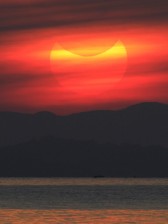
An annular solar eclipse occurs as the moon passes between the Earth and the sun as partially seen at sunrise Monday from the coastal township of Gumaca, Quezon province, 187 kilometers (116 miles) southeast of Manila, Philippines. Millions of Asians watched as a rare "ring of fire" eclipse crossed their skies early Monday. AP/BULLIT MARQUEZ
MANILA, Philippines – Some Metro Manila residents woke up extra early while motorists stopped along roads to gaze up at the annular eclipse Monday morning, Radyo Inquirer 990AM reports said.
Along United Nations Avenue in Manila, a report said that motorists shielded their eyes to safely see the rare eclipse bathe the skies in an orange glow.
Observers also gathered in Katipunan Avenue to watch the moon as it passed in front of the sun, another report said.
The Philippine Atmospheric Geophysical and Astronomical Services Administration (Pagasa) meanwhile warned against looking directly at the eclipse.
Professor Edmund Rosales, former president of the Philippine Astronomical Society, told Radyo Inquirer that other countries in Asia saw the eclipse sooner while some also saw the rare “ring of fire”.
“Medyo late na natin nakita. Before sunrise sa ibang bansa nakita na,” he said, explaining that the “ring of fire” was not something all countries could witness. “Nasa labas tayo nun, partial solar eclipse lang (ang nakita natin).”
For those who missed the eclipse, Rosales reminded everyone to mark their calendars for the Transit of Venus on June 6 which he described to be just as remarkable as the “ring of fire”.
“Visible yun (pero) dapat may solar filter or welder’s glass (ka),” he cautioned those who planned on looking directly at the rare event. “Bawal yun, nakakasiar ng mata (pati na ang) telescope kung walang tamang filter.”
It said that the eclipse started shortly before 6 a.m. and lasted up until 7 a.m. The next annular eclipse would occur in 2023.
For more of the reports, listen to Radyo Inquirer 990AM.


